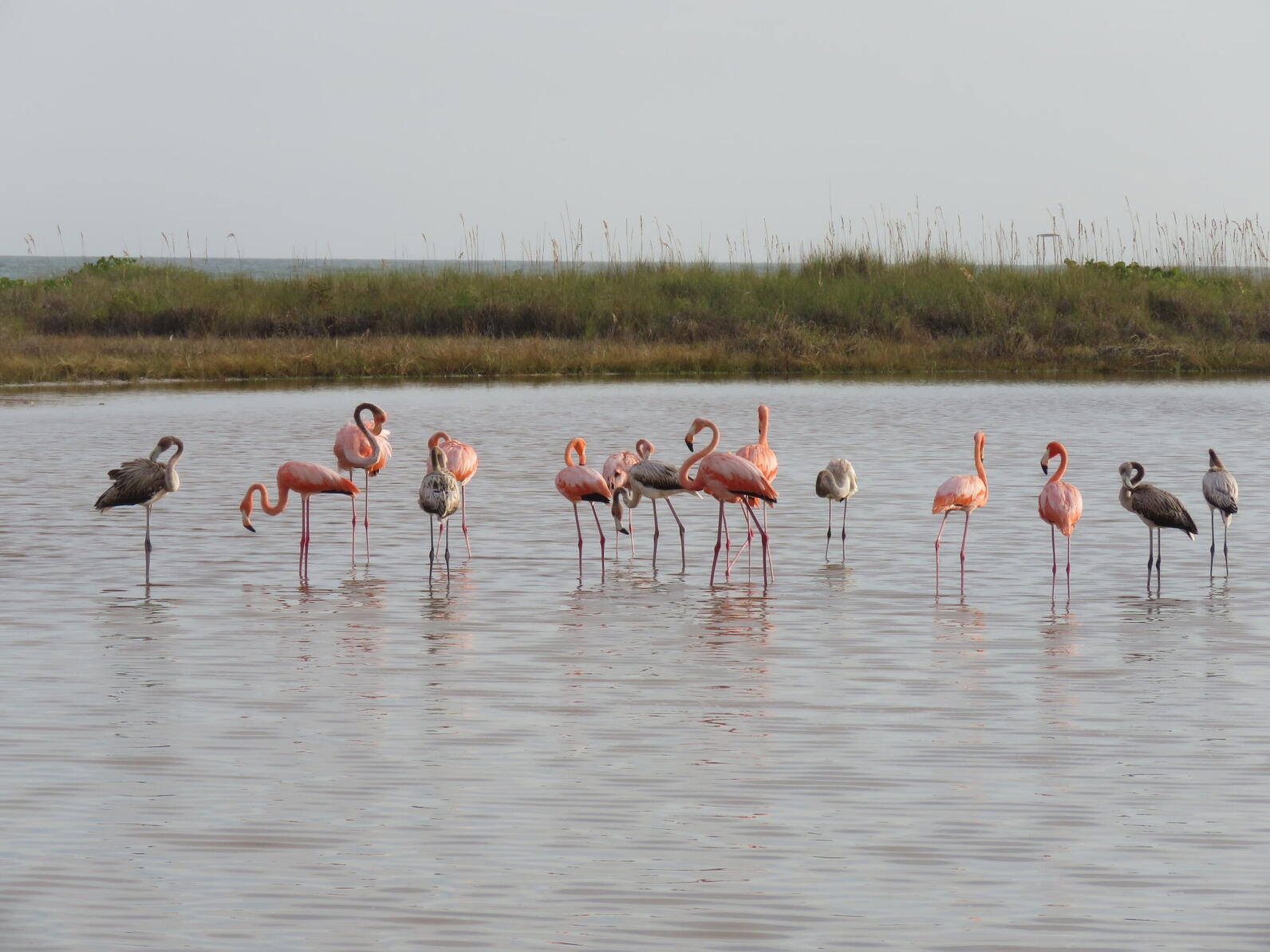Tropical storms may have spared our beaches until the end of summer, but coastal nesting species still had to contend with record-breaking heat. Hurricane Idalia and subsequent beach and island overwashes effectively ended the nesting season for much of the state.
SOUTHWEST FLORIDA
Carlos Point in Lee County successfully fledged almost 400 Black Skimmer chicks and more than 300 Least Tern chicks. Additionally, Fort Myers Beach fledged 21 Wilson’s Plover chicks, and Lee County as a whole fledged 21 Snowy Plovers. Unfortunately, in Collier County, the historically successful Marco Pass CWA colony completely failed. Though the colony began with approximately 900 Black Skimmer adults, they never nested. A small colony at Second Chance Critical Wildlife Area resulted in 100 Black Skimmer nests, and staff continue to monitor chicks as we head into the fall season. Across Collier County, 32 Wilson’s Plover pairs fledged 16 chicks.
PANHANDLE
Audubon biologists monitored nests of several tern species, including Caspian, Royal, Sandwich, Least, and Sooty Terns; as well as Brown Pelicans, American Oystercatchers, Wilson’s Plovers, and Snowy Plovers. But this year belonged to the Black Skimmers, with more than 175 fledged across the region. Black Skimmers nested on Flag and Lanark Critical Wildlife Areas, Pensacola Beach, and Navarre Beach. In the absence of overwash from storm events or abnormally high tides, Flag Island had two rounds of skimmer nesting. The Pensacola colony settled on their site after being displaced from their first nest site at Gulf Islands National Seashore, while the Navarre Beach colony settled on a sandy empty lot site after nesting attempts at two other sites in the area.

TAMPA BAY REGION – BEACHES
The team celebrated a triple-chick nest of American Oystercatchers this year at Fort De Soto Park, a testament to the partnerships between the park staff, Audubon, and Florida Fish and Wildlife Conservation Commission (FWC) that kept the young birds safe during a busy beach season. An additional successful partnership between Audubon Florida, Sarasota County, and the FWC resulted in 104 Least Tern and 320 Black Skimmer fledges on Lido Key—colonies that accounted for all the Least Terns and more than 75% of Black Skimmers from Audubon-monitored sites. Unfortunately, high tides and summer storms drenched beaches in overwash in Pinellas County, wiping out many Snowy Plover, Wilson’s Plover, Least Tern, and Black Skimmer nests. Only two Wilson’s Plovers nests in Greater Tampa Bay monitored by Audubon successfully fledged in 2023.
TAMPA BAY REGION – ROOFTOPS
Across 30 active rooftops in Pinellas, Pasco, Hillsborough, and Sarasota counties, staff recorded 20 Least Tern colonies, nine American Oystercatcher pairs, three Black Skimmer colonies, and six Killdeer pairs. With the FWC, Audubon and volunteers installed 2,750 feet of fencing to protect chicks from falling off the roof, as well as 198 chick shelters. While flooding and predation continued to pose problems for the nesting birds, we were delighted to discover a brand-new rooftop colony in Sarasota.
FLORIDA COASTAL ISLANDS SANCTUARIES
The Richard T. Paul Alafia Banks Sanctuary, leased from and managed in collaboration with The Mosaic Company and Port Tampa Bay as a bird sanctuary, provided homes to 6,000 bird pairs across 15 species. White Ibis proved to be the most numerous, but five state-Threatened bird species fledged chicks as well, including Reddish Egret, Roseate Spoonbill, Tricolored Heron, and Little Blue Heron.
Staff monitored a mixed Wood Stork and wading bird colony in Tampa this year, hosting the annual Colony Watch volunteer training on the site in coordination with the owners. Unfortunately, the colony experienced some bird die-offs of undetermined causes as well as disturbance from a neighbor removing trees during nesting season. In good news though, the manager of the site and our volunteers alerted Audubon to both of these issues, prompting further investigation that will ultimately help the birds.
NORTHEAST FLORIDA
Unfortunately, St. Johns County experienced a difficult nesting season. Least Tern, Wilson’s Plover, Black Skimmer, and American Oystercatcher gave it their best shot, but habitats reduced by erosion, plagued by overwash, and under intense pressure from predators could not sustain chicks until fledging. In Duval and Nassau counties, the nesting areas around Nassau Sound produced young of several species: Gull-billed Tern, Least Tern, and around two dozen Black Skimmers! Several Wilson’s Plover nests were primarily concentrated on Little Talbot Island—a state park that is central to their success. Huguenot Memorial Park, despite its struggles with erosion and large crowds, produced hundreds of Laughing Gull and Royal Tern chicks. Well over 50 Sandwich Tern chicks fledged this year, too.
This article originally appeared in the Fall 2023 issue of The Naturalist magazine.




















